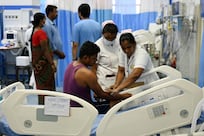This week, several thousand leading investors, financial experts and business people attended the Milken Institute 2012 Global Conference, one of the world's largest annual institutional investor conventions.
The focus on the discussions about the Arab region stems from the premise that a lack of economic opportunity was a major, if not the main, catalyst for the start of the Arab Spring.
The past year involved unrest in parts of the Middle East and North Africa launched by educated young professionals who are unemployed and underemployed.
A year later, their demands are still simmering: according to the World Bank, economic growth will have to accelerate dramatically to bridge the demand for jobs across the Middle East.
This requires at least doubling the annual net growth rate of job creation, increasing labour force participation and ensuring growth reaches more labour-intensive industries even as technology is adopted to increase efficiency.
Financial leaders discussed in Los Angeles how creating jobs and economic opportunities would improve the region's prospects of stability. Still, no knowledge or experience will enable anyone to predict where all this change is heading. We are, to be sure, in uncharted waters.
What can be predicted with certainty is that unless the region creates jobs, and many of them, the unrest will continue to unravel and the impact of despair will be felt globally. The size of the youth bulge is key to addressing this most vital of issues.
The demographic challenge can be turned into an opportunity that unlocks the latent development potential. The adverse global economic conditions make the challenge of creating jobs appear even more insurmountable.
At 50 per cent, Spain, for instance, has youth unemployment as high as the average youth unemployment in the Arab region. The whole of Europe is not much better off either.
The Middle East's youth bulge, while often seen as a challenge, must be turned into an opportunity. Unlike Europe, in the Middle East the growth of the economically active population exceeds that of the economically dependent.
This demographic gift that east Asia so effectively used in the 1990s gives the region a key competitive advantage that is not yet effectively tapped.
While the repercussions of inaction are primarily political, leadership on job creation must come from the private sector. The most effective role governments can play is to create and preserve the conditions that will be conducive to the flourishing of entrepreneurship.
Governments must become, and be seen as, enablers and not as obstacles. Only until governments assume this role, and the economies are freed from the burdens of politics, will the people of the region feel liberated from the shackles of poverty and despair.
The UAE has made great strides in creating a safe and world-class environment where economic development can flourish. The country provides endless opportunities for its local population and offers citizens from the rest of the region chances they cannot find in their native countries.
Key to the success of the UAE model was the creation of both hard and soft infrastructure that gave entrepreneurs the confidence to develop and eagerness to expand. The Dubai International Financial Centre (DIFC) stands head and shoulders above global competitors. Abu Dhabi's Masdar City and twofour54 are two other examples.
The country is home to two world-leading airlines. Other countries in the region look with great admiration at how the UAE became what it is now. The key ingredient of the country's success, that others in the region must strive to emulate, is the creation of conditions that enabled entrepreneurship to flourish.
Masdar, DIFC and the other projects are only the results of successful and continuing plans to diversify the economy. Countries in the region are well advised to create similar conditions, not a simple copying of the results.
Notwithstanding the current near-impossibility to raise the capital needed for similar mega-projects, the main lesson that other countries in the region can learn from the UAE regards the ability to unleash the private sector and create the necessary climate for it to flourish.
In addition, intra-regional collaboration can only enhance results.
There is no simple formula to address the root cause of the Arab Spring, which largely remains unchanged, if not even more aggravated, and remains a threat to regional and global stability.
However, the longer it takes to tackle unemployment and promote economic development, the greater will the challenge become.
Inaction means that more than 80 million unemployed Arab youth are unlikely to sit idly by, and the outcome of that is simply be too horrendous to contemplate.
The solution is economic and its implementation must start in earnest.
Ghanem Nuseibeh is a partner at Cornerstone Global Associates and a senior analyst with Political Capital
twitter: Follow and share our breaking business news. Follow us
iPad users can follow our twitterfeed via Flipboard - just search for Ind_Insights on the app.





